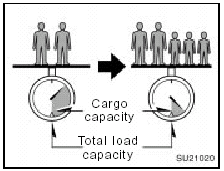 Toyota Yaris: Cargo and luggage
Toyota Yaris: Cargo and luggage
—Stowage precautions
When stowing cargo and luggage in the vehicle, observe the following:
- Put cargo and luggage in the luggage compartment when at all possible. Be sure all items are secured in place.
- Be careful to keep the vehicle balanced.
Locating the weight as far forward as possible helps maintain the balance.
- For better fuel economy, do not carry unneeded weight.
CAUTION.
To prevent cargo and luggage from sliding forward during braking, do not stack anything in the luggage compartment higher than the seatbacks.
Keep cargo and luggage low, as close to the floor as possible.
Never allow anyone to ride in the luggage compartment. It is not designed for passengers.
They should ride in their seats with their seat belts properly fastened. Otherwise, they are much more likely to suffer serious bodily injury, in the event of sudden braking or a collision.
Do not place anything on the luggage cover. Such items may be thrown about and possibly injure people in the vehicle during sudden braking or an accident. Secure all items in a safe place.
Do not drive with objects left on top of the instrument panel.
They may interfere with the driver’s field of view. Or they may move during sharp vehicle acceleration or turning, and impair the driver’s control of the vehicle. In an accident they may injure the vehicle occupants.
NOTICE.
Do not load the vehicle beyond the vehicle capacity weight given in Section 8.
—Capacity and distribution
Cargo capacity depends on the total weight of the occupants.
(Cargo capacity) = (Total load capacity) – (Total weight of occupants)
Steps for Determining Correct Load Limit—
(1) Locate the statement “The combined weight of occupants and cargo should never exceed XXX kg or XXX lbs.” on your vehicle’s placard.
(2) Determine the combined weight of the driver and passengers that will be riding in your vehicle.
(3) Subtract the combined weight of the driver and passengers from XXX kg or XXX lbs.
(4) The resulting figure equals the available amount of cargo and luggage load capacity. For example, if the “XXX” amount equals 1400 lbs. and there will be five 150 lb passengers in your vehicle, the amount of available cargo and luggage load capacity is 650 lbs. (1400–750 (5x150)=650 lbs.).
(5) Determine the combined weight of luggage and cargo being loaded on the vehicle. That weight may not safely exceed the available cargo and luggage load capacity calculated in Step 4.
(6) If your vehicle will be towing a trailer, load from your trailer will be transferred to your vehicle.
Consult this manual to determine how this reduces the available cargo and luggage load capacity of your vehicle.
Except for Canada—Toyota does not recommend towing a trailer with your vehicle. Your vehicle is not designed for trailer towing.
For Canada—For details about trailer towing.

Example on Your Vehicle
In case that 2 people with the combined weight of 166 kg (366 lb.) are riding in your vehicle with the total load capacity of 383 kg (845 lb.), the available amount of cargo and luggage load capacity will be as follows:
383 kg – 166 kg = 217 kg.
(845 lb. – 366 lb. = 479 lb.)
From this condition, if 3 more passengers with the combined weight of 176 kg (388 lb.) get on, the available cargo and luggage load will be reduced as follows:
217 kg – 176 kg = 41 kg.
(479 lb. – 388 lb. = 91 lb.)
As shown in the above example, if the number of occupants increases, the cargo and luggage load equaling the combined weight of occupants who got on later must be reduced. In other words, if the increase in the number of occupants causes the excess of the total load capacity (combined weight of occupants plus cargo and luggage load), you have to reduce the cargo and luggage on your vehicle.
For details about total load capacity, see “Vehicle load limits”.
CAUTION.
Even if the total load of occupant’s weight and the cargo load is less than the total load capacity, do not apply the load unevenly.
That may cause not only damage to the tire but also deterioration to the steering ability due to unbalance of the vehicle, causing an accident.
 Vehicle load limits
Vehicle load limits
Vehicle load limits include total load capacity, seating capacity, towing capacity
and cargo capacity. Follow the load limits shown below. Total load capacity and
seating capacity are also describ ...
 Types of tires
Types of tires
Determine what kind of tires your vehicle is originally equipped with.
1. Summer tires
Summer tires are high-speed capability tires best suited to highway driving under
dry conditions.
Since ...
See also:
Front body pillar (CUT): Sedan
REPLACEMENT
With the cowl top side upper panel removed.
REMOVAL
INSTALLATION
Temporarily install the new parts and measure each part of the new parts in accordance
with the body dimension ...
Front seats
Driver’s seat
Seat position adjustment lever
Seatback angle adjustment lever
Vertical height adjustment lever (if equipped)
Vertical height adjustment lever (if equipped) ...
Your Toyota’s identification
—Vehicle identification number
The vehicle identification number (VIN) is the legal identifier for your vehicle.
This number is on the left top of the instrument panel, and can be seen through ...
